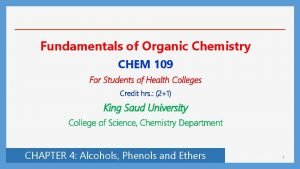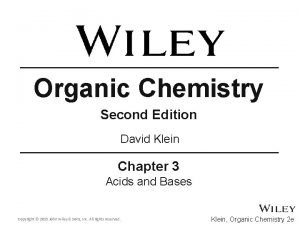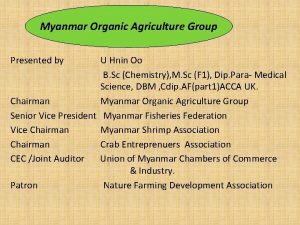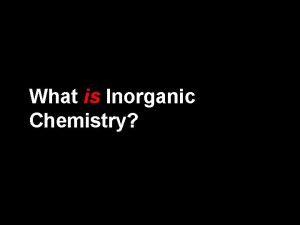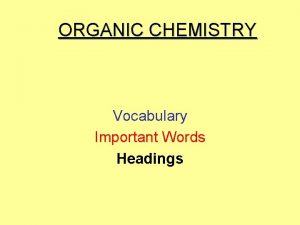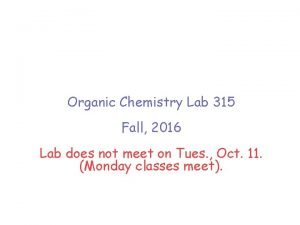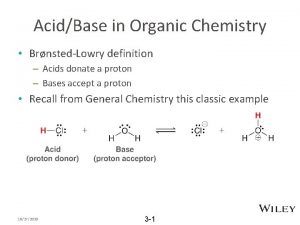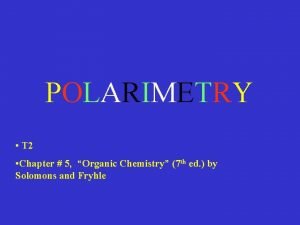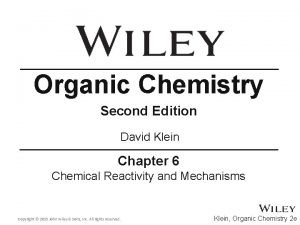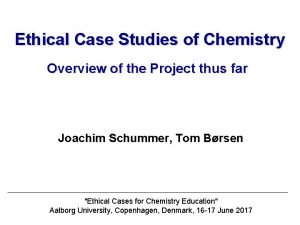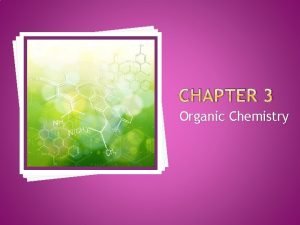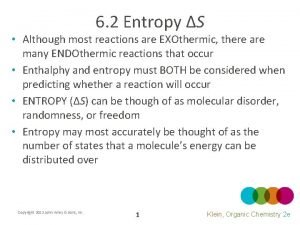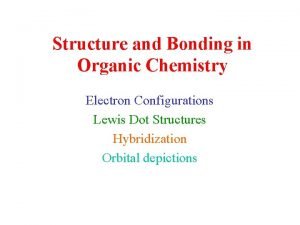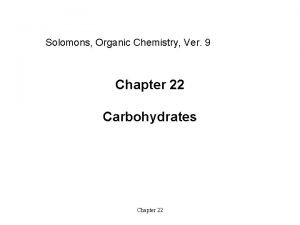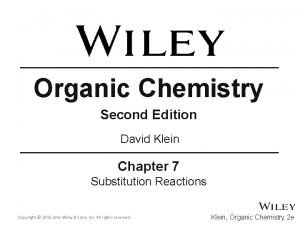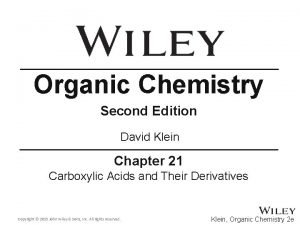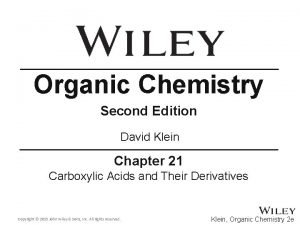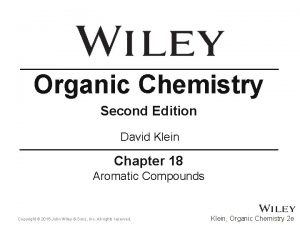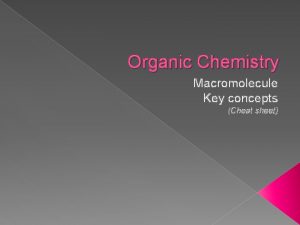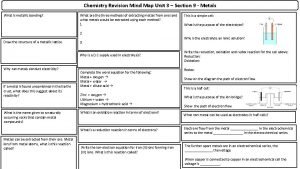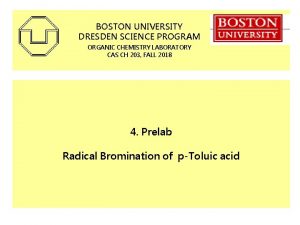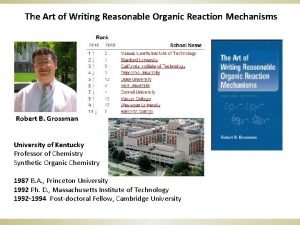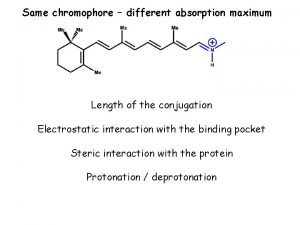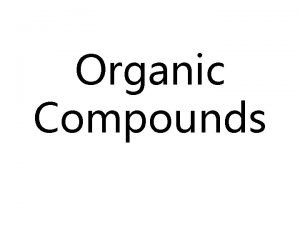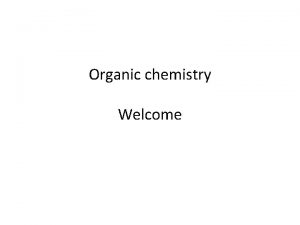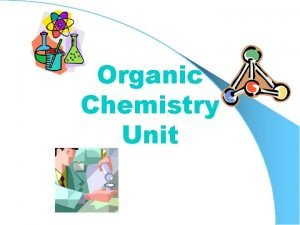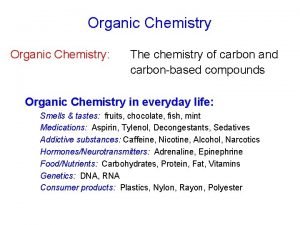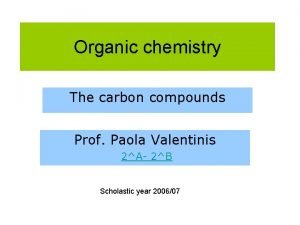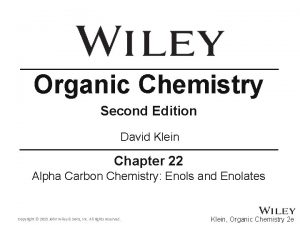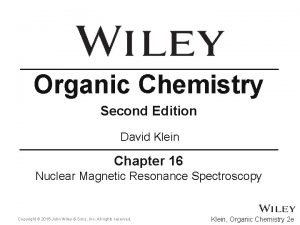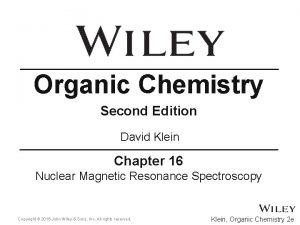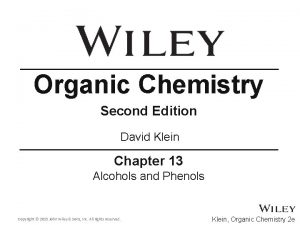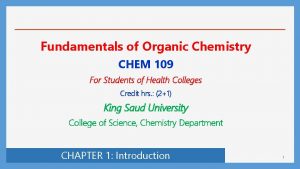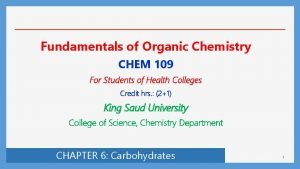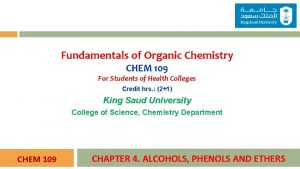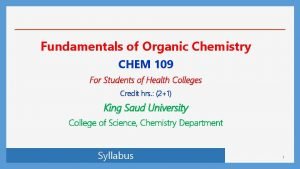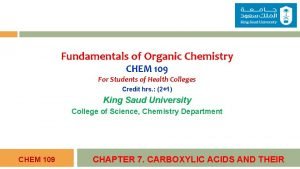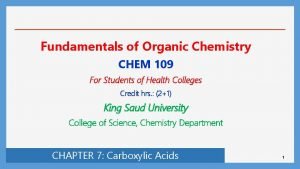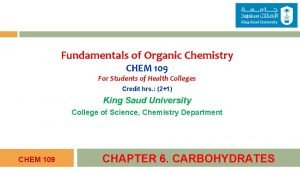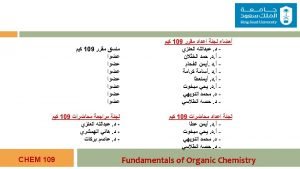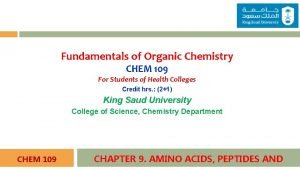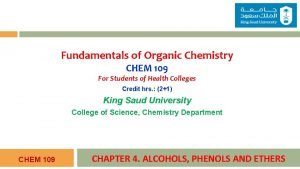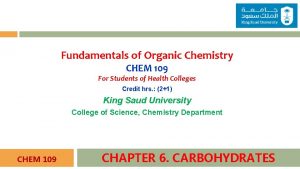Fundamentals of Organic Chemistry CHEM 109 For Students












































































- Slides: 76

Fundamentals of Organic Chemistry CHEM 109 For Students of Health Colleges Credit hrs. : (2+1) King Saud University College of Science, Chemistry Department CHEM 109 CHAPTER 2. ALIPHATIC HYDROCARBON

Hydrocarbons 2 o Hydrocarbons are Organic Compounds, which contain only the two elements carbon and hydrogen. o Aliphatic hydrocarbons are subdivided into: Ø Saturated hydrocarbons § Alkanes; Cn. H 2 n+2 (contain carbon-carbon single bond) § Cycloalkanes: Cn. H 2 n (contain carbon-carbon single bond in a singleand ring) Alkanes cycloalkanes are so similar that many of their properties can be considered side by side. Ø Unsaturated hydrocarbons § Alkenes : Cn. H 2 n § Alkynes : Cn H 2 n-2 (contain carbon-carbon double bond) (contain carbon-carbon triple bond)

Hydrocarbons 3 Hydrocarbon s Aromatic Aliphatic Unsaturated Cyclic Alkanes (Paraffin's) Single ring Fused ring Unsaturated Saturated Conjoined benzene ring Cn. H 2 n+2 Alkenes (Olefins) Cn. H 2 n Alkynes (Acetylenes) Cn. H 2 n-2

Saturated Hydrocarbons 1. Alkanes 4 o General formula is Cn. H 2 n+2 o In alkanes, the four sp 3 orbitals of carbon repel each other into a TETRAHEDRAL arrangement with bond angles of 109. 5º like in CH 4. o Each sp 3 orbital in carbon overlaps with the 1 s orbital of a hydrogen atom to form a C-H bond.

Saturated Hydrocarbons 1. Alkanes 5 Names, Molecular formulas and Number of Isomers of the first ten Alkanes Name Molecular Formula Number of isomers Methane CH 4 1 Ethane C 2 H 6 1 Propane C 3 H 8 1 Butane C 4 H 10 2 Pentane C 5 H 12 3 Hexane C 6 H 14 5 Heptane C 7 H 16 9 Octane C 8 H 18 18 Nonane C 9 H 20 35 Decane C 10 H 22 75

6 Structural Isomerism Saturated Hydrocarbons 1. Alkanes o Isomers are different compounds with identical molecular formulas. The phenomenon is called isomerism. o Structural or constitutional isomers are isomers which differ in the sequence of atoms bonded to each other. o Examples: Ø Butanes, C 4 H 10. Ø Pentanes, C 5 H 12.

7 Classes of Carbons and Hydrogen Saturated Hydrocarbons 1. Alkanes o A primary (1 ) carbon is one that is bonded to only one other carbon. o A secondary (2 ) carbon is one that is bonded to two other carbons. o A tertiary (3 ) carbon is one that is bonded to three other carbons. o Hydrogens are also referred to as 1 , 2 , or 3 according to the type of carbon they are bonded to.

8 Saturated Hydrocarbons 1. Alkanes Alkyl Groups o An alkyl group is an alkane from which a hydrogen has been removed. o General formula Cn. H 2 n+1. o Alky group is represented by R. o Nomenclature of alkyl groups by replacing the suffix – ane of the parent alkane by –yl. i. e. Alkane – ane + yl = Alkyl o Examples: Ø Methane CH 3 - (Methane – ane + yl) = methyl

9 Alkyl Groups Saturated Hydrocarbons 1. Alkanes Ø Ethan e CH 3 CH 2 - (Ethane – ane + yl) = ethyl Ø Propane – ane + yl = n-propyl or isopropyl

10 Alkyl Groups Ø Butan e Saturated Hydrocarbons 1. Alkanes

11 Saturated Hydrocarbons 1. Alkanes Alkyl Groups Alkane Alkyl Group Abbreviation CH 3—H Methane becomes CH 3— Methyl Me– CH 3 CH 2—H Ethane becomes CH 3 CH 2— Ethyl Et– CH 3 CH 2—H Propane becomes CH 3 CH 2— Propyl Pr– CH 3 CH 2 CH 2—H Butane becomes CH 3 CH 2 CH 2— Butyl Bu–

12 Nomenclatu re Saturated Hydrocarbons 1. Alkanes o Most organic compounds are known by two or more names: Ø The older unsystematic names, (Common names). Ø The IUPAC names. International Union of Pure & Applied Chemistry

13 Nomenclatu re The IUPAC Rules the 1) Select structure. Saturated Hydrocarbons 1. Alkanes parent the longest continuous chain not X Propyl Ethyl pentane hexane The longest continuous chain is not necessarily straight.

14 Saturated Hydrocarbons 1. Alkanes Nomenclatu re The IUPAC Rules 2) Number the carbons in the parent chain starting from the end which gives the lowest number for the substituent 1 2 3 6 5 4 4 5 6 3 -Ethylhexan e not 3 2 1 X 4 -Ethylhexan e

15 Nomenclatu re The IUPAC Rules Saturated Hydrocarbons 1. Alkanes 2) Number the carbons in the parent chain 2 -Methylpentane

16 Nomenclatu re The IUPAC Rules To name the compound; Saturated Hydrocarbons 1. Alkanes 1) The position of the substituent on the parent carbon chain by a number. 2) The number is followed by a hyphen (-). 3) The combined name of the substituent (ethyl). 4) The parent carbon chain (hexane) 3 - Ethyl hexane

Saturated Hydrocarbons 1. Alkanes 17 Nomenclatu re The IUPAC Rules 3) If the same alkyl substituent occurs more than once on the parent carbon chain, the prefixes di-, tri-, tetra-, penta-, and so on are used to indicate two, three, four, five, and so on. 5 4 3 2 1 2, 2, 4 - Tri methylpentane

18 Nomenclatu re The IUPAC Rules Saturated Hydrocarbons 1. Alkanes

Saturated Hydrocarbons 1. Alkanes 19 Nomenclatu re The IUPAC 4) If. Rules different alkyl substituents are attached on the parent carbon chain, they are named in order of order. 8 7 6 5 4 3 alphabetical 2 1 3, 3 - di ethyl 4 - methyl 5 - propyl 3, 3 -Diethyl- 4 -methyl- 5 - propyloctan e

Saturated Hydrocarbons 1. Alkanes 20 Nomenclatu re The IUPAC Note Rules that each substituent is given a number corresponding to its location on the longest chain. The substituent groups are listed alphabetically. 5) When two substituent are present on the same carbon, use the number twice.

21 Nomenclatu re The IUPAC Rules Saturated Hydrocarbons 1. Alkanes 6) When two chains of equal length compete for selection as the parent chain, choose the chain with the greater number of substituents.

Saturated Hydrocarbons 1. Alkanes 22 Nomenclatu re The IUPAC 7) If Rules substituents other than alky groups are also presents on the parent all substituents are named alphabetically. carbon chain; 5 4 3 2 1 3 -brom -2 -chloro- 4 -methylpentan 2 -chloro 3 -brom 4 -omethyl

23 Sources of Alkanes Saturated Hydrocarbons 1. Alkanes o The two principal sources of alkanes are petroleum and natural gas. Petroleum and natural gas constitute the chief sources of - Alkanes up to 40 -Carbons -Aromatic Alicyclic (Cyclic aliphtic hydrocarbons) Heterocyclic

24 Saturated Hydrocarbons 1. Alkanes Sources of Alkanes Petroleum Refining Some components of refined Fraction petroleum Boiling range (°C) Caron content Gas Below 20 C 1 – C 4 Petroleum ether 20 – 60 C 5 – C 6 Naphtha 60 – 100 C 6 – C 7 Gasoline 40 – 200 C 5 – C 10 Kerosine 175 – 325 C 11 – C 18 Gas oil 300 – 500 C 15 – C 40 Lubricating oil, asphalt, petroleum coke and Above 400 C 15 – C 40

Saturated Hydrocarbons 1. Alkanes 25 Physical Properties of Alkanes, Alkenes and Alkynes Those properties that can be observed without the compound undergoing a chemical reaction. A. Physical States C 1 (C 2) to C 4 are gases, C 5 to C 17 are liquids, C 18 and larger alkanes are wax –like B. solids. Solubility o Alkanes, Alkenes and Alkynes are nonpolar compounds. o Their solubility “ Like dissolve o like” Alkanes, Alkenes and Alkynes are soluble in the nonpolar solvents; carbon tetrachloride, CCl 4 and o Alkanes, Alkenes and Alkynes are insoluble in polar solvents like benzene,

26 Physical Properties C. Boiling Points Saturated Hydrocarbons 1. Alkanes o Boiling point decreases with increasing branches o Boiling point increases with increasing molecular weight.

Saturated Hydrocarbons 1. Alkanes 27 Preparation of Alkanes 1) Hydrogenation of Alkenes and Alkynes A great number of alkanes can be obtained by fractional distillation of crude petroleum and subsequent reactions as follows: 1. Catalytic hydrogenation: Alkenes and alkynes react with hydrogen in the presence of metal catalysts such as nickel, palladium, and platinum to produce alkanes. General Reaction

28 Preparation of Alkanes 1) Hydrogenation of Alkenes and Alkynes o Specific Examples Saturated Hydrocarbons 1. Alkanes

29 Preparation of Alkanes 2) Hydrolysis of Grignard Reagent Saturated Hydrocarbons 1. Alkanes o Grignard reagents react readily with any source of protons to give hydrocarbons. 3) By coupling of alkyl halides with dialkyl cuprate (all kinds of alkanes)

Saturated Hydrocarbons 1. Alkanes Notations for bond breaking and bond 30 making o A covalent bond can be broken in either two ways, Ø Homolytic cleavage. Ø Heterolytic cleavage. Free radicals Carbocation Carboanion

31 Reactions of Alkanes Saturated Hydrocarbons 1. Alkanes Saturated hydrocarbons undergo very few reactions, so they are called Paraffinic hydrocarbons. (Latin parum, little; affinis, affinity) Halogenatio n The halogenation of an alkane appears to be a simple free radical substitution in which a C-H bond is broken and a new C-X bond is formed Combustio n

32 Reactions of Alkanes A. Halogenation o Substitution reaction Saturated Hydrocarbons 1. Alkanes of alkanes, i. e. replacement of hydrogen by halogen, usually chlorine or bromine, giving alkyl chloride or alkyl bromide. o Flourine reacts explosively with alkanes It is unsuitable reagent for the preparation of the alkyl flourides. o Iodine is too unreactive It is not used in the halogentaion of alkanes. o Halogenation of alkanes take place athigh temperatures or under the influence of ultraviolet light

33 Reactions of Alkanes A. Halogenation Saturated Hydrocarbons 1. Alkanes o Chlorination of an alkane usually gives a mixture of products

34 2. ALKENES

The Structure of Alkenes 35 o Alkenes are ydrocarbons that contain a carbon–carbon double bond. o Alkenes are also Olefins. o General formula is Cn. H 2 n o The simplest members of the Alkenes series are C 2 & C 3

The Structure of Alkenes 36 o Hybridization; sp 2 -hybridized o orbitals The angle between them is 120° and bond length C=C (1. 34 Å). trigonal planar. o. A

Nomenclature of Alkenes 37 Common Names o The simplest members of the alkene and alkyne series are frequently referred to by their older common names, ethylene, acetylene, and propylene. o Two important groups also have common names; They are the vinyl and allyl groups are used in common names. o These

Nomenclature of Alkenes 38 The IUPAC The Rules IUPAC rules for naming alkenes are similar to those for alkanes, but a few rules must be added for naming and locating the multiple bonds. 1. The ending -ene is used to designate a carbon–carbon double bond. 2. Select the longest chain that includes both carbons of the double bond. 3. Number the chain from the end nearest the double bond so that the carbon atoms in that bond have the lowest possible numbers.

Nomenclature of Alkenes 39 If the multiple bond is equidistant from both ends of the chain, number the chain from the end nearest the first branch point. 4. Indicate the position of the multiple bond using the lower numbered carbon atom of that bond.

Nomenclature of Alkenes 40 NOTE S root of the name (eth- or prop-) tells us the number of carbons, and the The ending (-ane, -ene, or -yne) tells us whether the bonds are single, double, or triple. No number is necessary in these cases, because in each instance, only one structure is possible. With four carbons, a number is necessary to locate the double bond.

Nomenclature of Alkenes 41 o Branches are named in the usual way.

Nomenclature of Alkenes 42 o With cyclic hydrocarbons, we start numbering the ring with the carbons of the double bond.

Nomenclature of Alkenes 43 Example: Write the structural formula of 4 -Isopropyl-3, 5 -dimethyl 2 -octene. 1) The parent carbon chain is an Octene. The double bond is located between the 2 nd and 3 rd carbons. 2) Two methyl groups are attached on the parent carbon chain, one on carbon 3 and the other on carbon 5. 3) An isopropyl group is attached on carbon 4. 4) Put the missing hydrogens to get the correct structure.

Geometric Isomerism in Alkenes 44 o In alkenes, geometric isomerism is due to restricted rotation about the carbon - carbon double bond. A) when W differs from X and Y from Z, Alkenes exist as geometric isomers o cis isomer; when two similar groups are on the same side of the double bond. o trans isomer; when two similar groups are on the opposite sides of the double bond. have different physical properties and can be separated by fractional o They crystallization or distillation.

Geometric Isomerism in Alkenes 45 B) If (W = X or Y = Z), geometric isomerism is not possible.

Geometric Isomerism in Alkenes 46 o For alkenes with four different substituent such as Another system, the E, Z system, o Basically, the E, Z system works as follows; Arrange the groups on each carbon of the C=C bond in order of priority o The priority depends on atomic number: The higher the atomic number of the atom directly attached to the doublebonded carbon, the higher the priority. Thus, in structure (I), Cl > F, and CH 3 > H.

Geometric Isomerism in Alkenes 47 o If the two groups of higher priority are on the same side of the C=C plane, The isomer is labeled Z; (from the German zusammen, together). o If the two groups of higher priority are on opposite sides of the C=C plane, The isomer is labeled E; (from the German entgegen, opposite).

Preparation of Alkenes 48 o Alkenes are prepared by Elimination of an atom or group of atoms from adjacent carbons to form carbon-carbon double bond. 1) Dehydration of Alcohols o When an alcohol is heated in the presence of a mineral acid catalyst, It readily loses a molecule of water to give an alkene. o The acid catalysts most commonly used are sulfuric acid, H 2 SO 4, and phosphoric acid, H 3 PO 4.

49 1) Dehydration of Alcohols Preparation of Alkenes Removal of OH group and a proton from two adjacent carbon atoms using mineral acids such as H 2 SO 4 or H 3 PO 4

50 1) Dehydration of Alcohols Preparation of Alkenes Which Alkene Predominates? ; Saytzeff’s Rule The loss of water from adjacent carbon atoms, can give rise to more than one alkene. Example: the dehydration of 2 -butanol. 2 -butene is the major (with two alkyl substituents attached to C=C) Saytzeff’s Rule applies In every instance in which more than one Alkene can be formedproduct is always the alkene with the most alkyl substituents The major attached on the double-bonded carbons.

51 1) Dehydration of Alcohols Preparation of Alkenes o Classes of Carbocations according to the number of carbon atoms attached to the positively charged carbon. o Generall 1. y The dehydration of alcohols requires an acid catalyst. 2. The predominant alkene formed follows Saytzeffs rule. 3. The reaction proceeds via a carbocation intermediate. 4. The stabilities of carbocations and the ease of dehydration of alcohols follows the order 3° > 2° > 1°.

52 2) Dehydrohalogenation of Alkyl Halides Preparation of Alkenes o Alkenes can also be prepared under alkaline conditions. heating an alkyl halide with a solution of KOH or Na. OH in alcohol, yields an alkene. 3) Dehalogenation of Vicinal Dibromides

Reactions of Alkenes 53 o The chemistry of alkenes can be divided into two general types of reactions: (1) Electrophilic Reactions Addition of Symmetric and Unsymmetric Reagents to symmetric Alkenes. 1. Addition of Hydrogen: Catalytic Hydrogenation 2. Addition of Halogens: Halogenation Addition of Unsymmetric Reagents to Unsymmetric Alkenes; Markovnikov’s 1. Addition Rule. of Hydrogen Halides 2. Addition of Sulfuric Acid 3. Addition of Water: Hydration 4. Addition of HOX: Halohydrin Formation

Reactions of Alkenes 54 (2) Substitution Reactions (3) Oxidation Reactions 1. Ozonolysis 2. Oxidation Using KMn. O 4

Reactions of Alkenes 55 Electrophilic Addition Reactions 1. Addition of Hydrogen: Addition Hydrogenation of a mole of hydrogen to carbon-carbon double bond of Alkenes in the presence of suitable catalysts to give an Alkane.

Reactions of Alkenes 56 Electrophilic Addition Reactions 2. Addition of Halogen: Halogenation When an alkene is treated at room temperature with a solution of bromine or chlorine in carbon tetrachloride to give the corresponding vicinal dihalide (two halogens attached to adjacent carbons) - Iodine is too unreactive and will not add to the double bond. - Fluorine is too reactive and reacts explosively with an alkene.

Reactions of Alkenes 57 Electrophilic Addition Reactions 3. Addition of o A variety Acidsof acids add to the double bond of alkenes. The hydrogen ion (or proton) adds to one carbon of the double bond, and the remainder of the acid becomes connected to the other carbon. o Acids that add in this way are the hydrogen halides (H-F, H-Cl, H-Br, H-I), and water (H-OH). Note that - Any electron-deficient species is called an electrophile. - Any electron-rich species is called a nucleophile.

58 Electrophilic Addition Reactions of Alkenes Examples of Electrophile: i) Positive reagents: protons (H+), alkyl group R+ , nitronium ion (NO 2+), etc…. ii) Neutral reagents having positively polarized centers: HCl, bromine (because it can be polarized so that one end is positive). iii) Lewis acids: molecules or ions that can accept an electron pair BF 3 and Al. Cl 3. iv) Metal ions that contain vacant orbitals: the silver ion (Ag+), the mercuric ion (Hg 2+), and the platinum ion (Pt 2+). Examples of Nucleophile: a)Negative ions b) Neutral molecules

Reactions of Alkenes 59 Electrophilic Addition Reactions 3. Addition of o The addition of H—A to an alkene is believed to be a two-step Acids process. Step 1. The hydrogen ion (the electrophile) attacks the ∏electrons of the alkene, forming a C—H bond a carbocation. Step 2. The negatively charged species A: - (a nucleophile) attacks the carbocation and forms a new C—A bond. o The attack by an electrophilic reagent on the ∏-electrons, falls in a general category called electrophilic addition reactions.

Reactions of Alkenes 60 Electrophilic Addition Reactions 3. 1. Addition of Hydrogen Halide Alkenes react with hydrogen chloride, HC 1, hydrogen bromide, HBr and hydrogen iodide, HI, to form alkyl halides, RX. Example s;

61 Electrophilic Addition Reactions of Alkenes o Reagents and alkenes can be classified as either symmetric or unsymmetric with respect to addition reactions. Ø If a reagent and/or an alkene is symmetric, only one addition product is possible. Ø But if both the reagent and the alkene are unsymmetric, two products are, in principle, possible.

62 Electrophilic Addition Reactions of Alkenes Markovnikov’s Rule In electrophilic addition of H—X to Unsymmetrical Alkenes the hydrogen of the hydrogen halide adds to the double-bonded carbon that bears the greater number of hydrogen atoms and the negative halide ion adds to the other double-bonded carbon.

63 Electrophilic Addition Reactions of Alkenes Explanation for Markovnikov’s Rule Example; Addition of HBr to propene o In modern terms Markovnikov’s rule can be restated: The addition of an unsymmetrical reagent HX to an unsymmetrical alkene proceeds in such a direction as to produce the more stable carbocation.

Reactions of Alkenes 64 Electrophilic Addition Reactions 3. 2. Addition of Water: If an acid. Hydration catalyst is present, water (as H-OH) adds to alkenes and the product is alcohol.

Oxidation 65 Reactions 1. Ozonolysis Reactions of Alkenes o The first product, a molozonide, is formed by cycloaddition of the oxygen at each end of the ozone molecule to the carbon–carbon double bond. then rearranges rapidly to an ozonide (explosive if o This product isolated). o They are usually treated directly with a reducing agent, commonly zinc and aqueous acid, to give carbonyl compounds as the isolated products.

Reactions of Alkenes 66 Oxidation Reactions 1. Ozonolysis o Ozonolysis can be used to locate the position of a double bond. o Example; Ozonolysis of 1 -butene gives two different aldehydes, whereas 2 -butene gives a single aldehyde.

Reactions of Alkenes 67 Oxidation Reactions 2. Oxidation Using Alkenes KMn. O react with alkaline potassium permanganate to form glycols 4 (compounds with two adjacent hydroxyl groups).

68 3. ALKYNES

The Structure of Alkynes 69 o Alkynes are hydrocarbons that contain a carbon–carbon triple bond. o Alkynes are also known as Acetylenes. o General formula is Cn. H 2 n-2 o Hybridization; sp-hybridized orbitals o The angle between them is 180° and the bond length 1. 20 A° o Linear.

Nomenclature of Alkynes 70 o The simplest members of the Alkenes series are C 2 & C 3 o Named are derived from the corresponding alkanes by replacing the –ane ending by –yne. o IUPAC rules as discussed for Alkenes. o Example: 3 -Chloro-2, 7 -dimethyl-4 -nonyne

Acidity of Alkynes 71 o A hydrogen atom on a triply bonded carbon (Terminal Alkyne) is weakly acidic and can be removed by a very strong base ( as Sodium amide). o Internal alkynes (Non-Terminal Alkyne) have no exceptionally acidic hydrogens. - Relative Acidity of the Hydrocarbon. Terminal alkynes, are more acidic than other hydrocarbons

Preparation of Alkynes 72 1) Dehydrohalogenation of Alkyl dihalides

Preparation of Alkynes 73 2) Reaction of Sodium Acetylide with Primary Alkyl Halides o Acetylen e o Monosubstituted Acetylenes

Preparation of Alkenes 74 Electrophilic Addition Reactions 1. Addition of Hydrogen: Hydrogenation o With an ordinary nickel or platinum catalyst, alkynes are hydrogenated all the way to alkanes. o However, a special palladium catalyst (called Lindlar’s catalyst) can control hydrogen addition so that only one mole of hydrogen adds. In this case, the product is a cis alkene.

Preparation of Alkenes 75 Electrophilic Addition Reactions 2. Addition of Halogen: Bromine. Halogenation adds as follows; In the first step, the addition occurs mainly trans. 3. Addition of Hydrogen Halide With unsymmetric triple bonds and unsymmetric reagents, Markovnikov’s Rule is followed in each step, as shown in the following example:

Preparation of Alkenes 76 Electrophilic Addition Reactions 4. Addition of Water: Hydration o Addition of water to alkynes requires not only an acid catalyst but mercuric ion as o o well. Although the reaction is similar to that of alkenes, the initial product - a vinyl alcohol or enol - rearranges to a carbonyl compound (keto form). The keto form of aldehydes and ketones are in equilibrium with the enol form. The keto from predominates at equilibrium for most simple aldehydes and ketones. The inter conversion is called keto-enol tautomerization.
 Chem 109
Chem 109 Functional groups ib chemistry
Functional groups ib chemistry Organic vs inorganic chemistry
Organic vs inorganic chemistry But pent hex hept
But pent hex hept Ario acronym chemistry
Ario acronym chemistry Founder of organic chemistry
Founder of organic chemistry Canola oil
Canola oil Ester organic chemistry
Ester organic chemistry Homologous series
Homologous series Organic chemistry david klein 3rd edition
Organic chemistry david klein 3rd edition Ee organic chemistry
Ee organic chemistry Ario organic chemistry
Ario organic chemistry Thermodynamic vs kinetic control
Thermodynamic vs kinetic control David klein organic chemistry
David klein organic chemistry Organic chemistry 2nd edition klein
Organic chemistry 2nd edition klein Ario practice problems
Ario practice problems Priority when naming organic compounds
Priority when naming organic compounds Objective lab report example
Objective lab report example Britannica.com
Britannica.com Grade 10 organic chemistry
Grade 10 organic chemistry Organic chemistry
Organic chemistry Organic chemistry introduction
Organic chemistry introduction Kiliani fischer synthesis
Kiliani fischer synthesis Cracking organic chemistry
Cracking organic chemistry Meth eth prop
Meth eth prop Organic chemistry myanmar
Organic chemistry myanmar Hhcchh
Hhcchh Gc organic chemistry
Gc organic chemistry Hono organic chemistry
Hono organic chemistry Vicinal dihalide
Vicinal dihalide Topic 11 organic chemistry
Topic 11 organic chemistry Chapter 22 review organic chemistry section 1 answers
Chapter 22 review organic chemistry section 1 answers Organic chemistry reaction pathways
Organic chemistry reaction pathways Organic chemistry nomenclature
Organic chemistry nomenclature What is organic chemistry like
What is organic chemistry like Organic vs inorganic
Organic vs inorganic Organic chemistry vocabulary
Organic chemistry vocabulary Organic chemistry third edition david klein
Organic chemistry third edition david klein Separation scheme of caffeine from vivarin tablets
Separation scheme of caffeine from vivarin tablets A level chemistry ocr organic synthesis
A level chemistry ocr organic synthesis Saponifiable lipids example
Saponifiable lipids example Ario+
Ario+ How to calculate yield in chemistry
How to calculate yield in chemistry Polarimetry organic chemistry
Polarimetry organic chemistry Organic chemistry third edition david klein
Organic chemistry third edition david klein Organic chemistry
Organic chemistry Hammonds postulate
Hammonds postulate Organic chemistry
Organic chemistry Organic chemistry chapter 9
Organic chemistry chapter 9 Chemistry-ethics case studies
Chemistry-ethics case studies Chapter 7 organic chemistry
Chapter 7 organic chemistry Nonene
Nonene Organic chemistry chapter 1 problem 59pp
Organic chemistry chapter 1 problem 59pp Hammond's postulate organic chemistry
Hammond's postulate organic chemistry Octane lewis structure
Octane lewis structure Oxidation of carbohydrates
Oxidation of carbohydrates Resonance in benzyl carbocation
Resonance in benzyl carbocation Organic chemistry
Organic chemistry Organic chemistry
Organic chemistry Organic chemistry
Organic chemistry Organic chemistry
Organic chemistry Macromolecules cheat sheet
Macromolecules cheat sheet Chemistry mind map
Chemistry mind map Organic chemistry stuart warren
Organic chemistry stuart warren Ir spectroscopy
Ir spectroscopy The art of writing reasonable organic reaction mechanisms
The art of writing reasonable organic reaction mechanisms Rhodopsin
Rhodopsin Organic chemistry
Organic chemistry Condensed structure of cyclohexane
Condensed structure of cyclohexane Organic chemistry
Organic chemistry Halohydrin formation
Halohydrin formation Isomers of pentane
Isomers of pentane Organic chemistry
Organic chemistry Organic chemistry
Organic chemistry Organic chemistry
Organic chemistry Organic chemistry
Organic chemistry Chemistry
Chemistry
